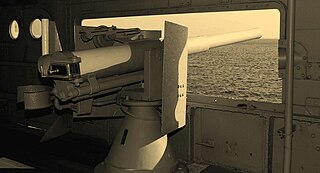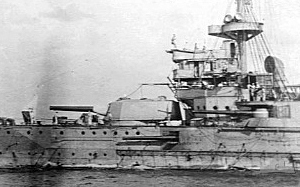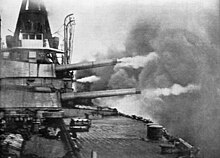
The BL 15-inch Mark I succeeded the BL 13.5-inch Mk V naval gun. It was the first British 15-inch (380 mm) gun design and the most widely used and longest lasting of any British designs, and arguably the most successful heavy gun ever developed by the Royal Navy. It was deployed on capital ships from 1915 until 1959 and was a key Royal Navy gun in both World Wars.

The BL 13.5 inch Mk V gun was a British heavy naval gun, introduced in 1912 as the main armament for the new super-dreadnought battleships of the Orion class. The calibre was 13.5 inches (343 mm) and the barrels were 45 calibres long at 607.5 inches. The guns were greatly superior to the unrelated earlier 13.5-inch (30-calibre) Mk I to Mk IV guns used on the pre-dreadnought battleship Admiral, Trafalgar and Royal Sovereign classes completed between 1888 and 1896.

The BL 16-inch Mark I was a British naval gun introduced in the 1920s and used on the two Nelson-class battleships. A breech-loading gun, the barrel was 45 calibres long meaning 45 times the 16-inch (406 mm) bore – 60 ft (18 m) long.

The QF 6-inch 40 calibre naval gun (Quick-Firing) was used by many United Kingdom-built warships around the end of the 19th century and the start of the 20th century. In British service it was known as the QF 6-inch Mk I, II, III guns. As the 15 cm/40 (6") 41st Year Type naval gun it was used for pre-dreadnought battleships, armoured cruisers and protected cruisers of the early Imperial Japanese Navy built in UK and European shipyards. It was also the heaviest gun ever carried by a pre-Cold War destroyer.

The QF 12-pounder 12-cwt gun (Quick-Firing) was a common, versatile 3-inch (76.2 mm) calibre naval gun introduced in 1894 and used until the middle of the 20th century. It was produced by Armstrong Whitworth, Elswick and used on Royal Navy warships, exported to allied countries, and used for land service. In British service "12-pounder" was the rounded value of the projectile weight, and "12 cwt (hundredweight)" was the weight of the barrel and breech, to differentiate it from other "12-pounder" guns.

The Armstrong Whitworth 12-inch naval gun of 40 calibres length was designed by and manufactured mainly by Armstrong's ordnance branch, Elswick Ordnance Company. It was intended for the Royal Navy's Royal Sovereign-class battleships, but budgetary constraints delayed their introduction. The first units were instead supplied to Japan. As the Type 41 12-inch (305 mm) 40-calibre naval gun it was the standard main battery on several early United Kingdom-built pre-dreadnought battleships of the Imperial Japanese Navy.

The Vickers 10 inch naval gun was used on battleships and armoured cruisers built during the first decade of the 20th century. They were used as the Type 41 10-inch /45-caliber aboard the British-built semi-dreadnought Katori-class battleships and the natively-built Satsuma-class battleships of the Imperial Japanese Navy.

The 14-inch/45-caliber gun,, whose variations were known initially as the Mark 1, 2, 3, and 5, and, when upgraded in the 1930s, were redesignated as the Mark 8, 9, 10, and 12. They were the first 14-inch (356 mm) guns to be employed by the United States Navy. The 14-inch/45-caliber guns were installed as the primary armament aboard all of the United States Navy's New York-class, Nevada-class, and Pennsylvania-class battleships. The gun also saw service in the British Royal Navy, where it was designated BL 14-inch gun Mk II.

The BL 12 inch Gun Mark X was a British 45-calibre naval gun which was mounted as primary armament on battleships and battlecruisers from 1906. It first appeared on HMS Dreadnought.

The BL 12-inch Mark XI and Mark XII gun were British breech loading (BL) naval guns of 50-calibres length mounted as primary armament on dreadnought battleships from 1910.

The BL 7.5-inch Mk II–Mk V guns were a variety of 50-calibre naval guns used by Britain in World War I. They all had similar performance and fired the same shells.

The BL 4.7-inch, 45-calibre gun was a British medium-velocity naval gun introduced in 1918 for destroyers. It was designed to counter a new generation of heavily armed German destroyers that were believed to be in development.

The BL 14 inch 45 calibre gun were various similar naval guns designed and manufactured by Elswick Ordnance Company to equip ships that Armstrong-Whitworth built and/or armed for several countries before World War I.

The EOC 10-inch 45 calibre gun were various similar 10-inch naval guns designed and manufactured by Elswick Ordnance Company to equip ships they built and/or armed for several countries before World War I.

The Vickers 14-inch 45-calibre gun was designed and built by Vickers and initially installed on the battlecruiser Kongō which it was building for the Imperial Japanese Navy. Guns similar to this Vickers design were also later built in Japan to arm Kongō's sister ships and subsequent Japanese-constructed "super-dreadnoughts" which were all built in Japan. Japanese-built versions of the guns were designated 14-inch 41st Year Type, and from 1917 when the Navy went metric they were redesignated 36 cm 41st Year Type.

The 15 cm/50 41st Year Type gun was a naval gun used by the Imperial Japanese Navy before and during World War II. It had a 152 millimetres (6.0 in) bore with a length of 7.6 metres (25 ft) and fired 45.4 kilograms (100 lb) shell for a distance of 18,000 metres (20,000 yd) or 21,000 metres (23,000 yd). The gun was first used in single casemates on the Kongō-class battlecruisers and Fusō-class battleships and later in the Agano-class light cruisers in twin mountings.

The Type 41 3-inch (76 mm) naval gun otherwise known as the 8 cm/40 3rd Year Type naval gun was a Japanese dual-purpose gun introduced before World War I. Although designated as 8 cm (3.15 in), its shells were 76.2 mm (3 in) in diameter.

By taking on ships being built for foreign navies in British shipyards, a number of British-built 6-inch 50-calibre naval guns found their way into British service in World War I. Their specifications and performance differed from standard Royal Navy 6-inch guns but in British service they fired standard service 100-pound projectiles.
The 15 cm/45 41st Year Type was a British naval gun designed by the Elswick Ordnance Company for export in the years before World War I that armed warships of the Imperial Japanese Navy. These guns served aboard Japanese ships during World War I and as coastal artillery during World War II.




















